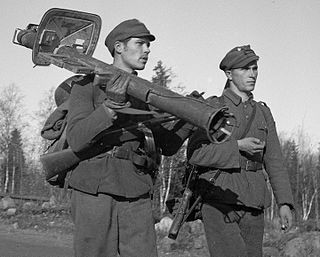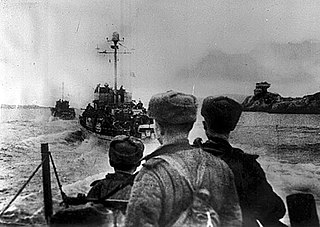
Rovaniemi is a city in Finland and the regional capital of Lapland. It is located near the Arctic Circle in the northern interior of the country. The population of Rovaniemi is approximately 66,000, while the sub-region has a population of approximately 69,000. It is the 17th most populous municipality in Finland, and the 12th most populous urban area in the country. Rovaniemi is also the largest city in Europe by land area.
The 21 municipalities of the Lapland Region in Finland are divided on six sub-regions:

Lapland is the largest and northernmost region of Finland. The 21 municipalities in the region cooperate in a Regional Council. Lapland borders the Finnish region of North Ostrobothnia in the south. It also borders the Gulf of Bothnia, Norrbotten County in Sweden, Finnmark County and Troms County in Norway, and Murmansk Oblast and the Republic of Karelia in Russia. The topography of Lapland varies from vast mires and forests in the south to fells in the north. The Arctic Circle crosses Lapland, so polar phenomena such as the midnight sun and polar night can be viewed in this region.

The Finnish Army is the land forces branch of the Finnish Defence Forces. The Finnish Army is divided into six branches: the infantry, field artillery, anti-aircraft artillery, engineers, signals, and materiel troops. The commander of the Finnish Army since 1 January 2022 is Lieutenant General Pasi Välimäki.

Kemi is a town and municipality of Finland. It is located very near the city of Tornio and the Swedish border. The distance to Oulu is 105 kilometres (65 mi) to the south and to Rovaniemi is 117 kilometres (73 mi) to the northeast. It was founded in 1869 by a decree of the Emperor Alexander II of Russia because of its proximity to a deepwater port.
The 3rd Division was a unit of the Finnish Army during the Continuation War. It initially fought in the northern Finland, participating in the Finno-German Operation Arctic Fox. In 1944, it was transferred to the Karelian Isthmus to defend against the Soviet Vyborg–Petrozavodsk offensive. Following the Moscow Armistice in 1944, the division was moved to Oulu and participated in the Lapland War.

Operation Arctic Fox[a] was the codename given to a World War II campaign by German and Finnish forces against Soviet Northern Front defenses at Salla, Murmansk Oblast, in July 1941. The operation was part of the larger Operation Silver Fox which aimed to capture the vital port of Murmansk. Arctic Fox was conducted in parallel to Operation Platinum Fox in the far north of Lappland. The principal goal of Operation Arctic Fox was to capture the town of Salla and then to advance in the direction of Kandalaksha to block the railway route to Murmansk.

Operation Silver Fox from 29 June to 17 November 1941, was a joint German–Finnish military operation during the Continuation War on the Eastern Front of World War II against the Soviet Union. The objective of the offensive was to cut off and capture the key Soviet Port of Murmansk through attacks from Finnish and Norwegian territory.

Finland participated in the Second World War initially in a defensive war against the Soviet Union, followed by another, this time offensive, war against the Soviet Union acting in concert with Nazi Germany and then finally fighting alongside the Allies against Germany.
Operation Platinum Fox was a German and Finnish military offensive launched during World War II. Platinum Fox took place on the Eastern Front and had the objective of capturing the Barents Sea port of Murmansk. It was part of a larger operation, called Operation Silver Fox.

The Battle of Petsamo was fought between Finnish and Soviet troops in the area of Petsamo in the far north of Finland in 1939 and 1940. The Finnish troops were greatly outnumbered but managed to contain the Soviet troops due to the extreme terrain, weather and leadership.

The Battle of Salla was fought between Finnish and Soviet troops near Salla in northern Finland during the Winter War. The Soviets had orders to advance through Salla to Kemijärvi and Sodankylä, and from there to Rovaniemi in just two weeks. From there they were to advance to Tornio and cut Finland in two. The Finnish troops managed to stop the Soviet advance just east of Kemijärvi. During the last days of February 1940 the Finnish troops were replaced with the Swedish, Norwegian and Danish volunteers of the Stridsgruppen SFK.

The Battle of Tornio was the first major engagement between Nazi Germany and Finland in the Lapland War; although hostilities had already begun elsewhere.

The Petsamo–Kirkenes offensive was a major military offensive during World War II, mounted by the Red Army against the Wehrmacht in 1944 in the Petsamo region, ceded to the Soviet Union by Finland in accordance with the Moscow Armistice, and Norway. The offensive defeated the Wehrmacht's forces in the Arctic, driving them back into Norway, and was called the "Tenth Shock" by Stalin. It later expelled German forces from the northern part of Norway and seized the nickel mines of Petsamo.

The Finnish invasion of Ladoga Karelia was a military campaign carried out by Finland in 1941. It was part of what is commonly referred to as the Continuation War. Early in the war, Finnish forces captured the Ladoga Karelia. It had been ceded to the Soviet Union on 13 March 1940, in the Moscow Peace Treaty, which marked the end of the Winter War. Later, in the summer of 1944, the Soviet Union recaptured the eastern part of Ladoga Karelia in the Vyborg–Petrozavodsk Offensive.

During World War II, the Lapland War saw fighting between Finland and Nazi Germany – effectively from September to November 1944 – in Finland's northernmost region, Lapland. Though the Finns and the Germans had been fighting together against the Soviet Union since 1941 during the Continuation War (1941–1944), peace negotiations between the Finnish government and the Allies of World War II had been conducted intermittently during 1943–1944, but no agreement had been reached. The Moscow Armistice, signed on 19 September 1944, demanded that Finland break diplomatic ties with Germany and expel or disarm any German soldiers remaining in Finland.
Operation Birke was a German operation late in World War II in Finnish Lapland to protect access to nickel.

The Province of Lapland was a province of Finland from 1938 to 2009.

The Liberation of Finnmark was an Allied military operation lasting from 23 October 1944 until 26 April 1945, in which Soviet and Norwegian forces wrested away control of Finnmark, the northernmost county of Norway, from Germany. It began with a Soviet offensive that liberated Kirkenes.

The Battle of Olhava occurred during the Lapland War on 28 September 1944. A brief armed struggle occurred in Northern Finland between retreating German troops and north of the advancement of the Finnish troops. The previous day the first skirmish between German and Finnish troops in Pudasjärvi. In Olhava, troops for the first time opened full-scale fire against each other and the casualties were the first of the Lapland War.

















